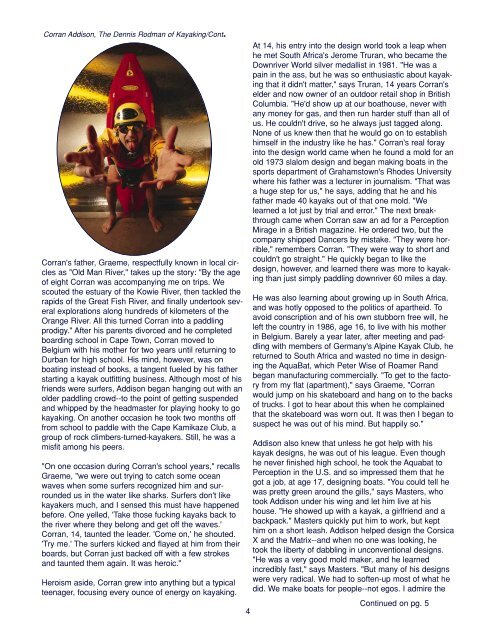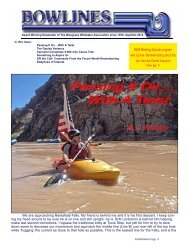JAN FEB04/B - Bluegrass Wildwater Association
JAN FEB04/B - Bluegrass Wildwater Association
JAN FEB04/B - Bluegrass Wildwater Association
You also want an ePaper? Increase the reach of your titles
YUMPU automatically turns print PDFs into web optimized ePapers that Google loves.
Corran Addison, The Dennis Rodman of Kayaking/Cont.<br />
Corran's father, Graeme, respectfully known in local circles<br />
as "Old Man River," takes up the story: "By the age<br />
of eight Corran was accompanying me on trips. We<br />
scouted the estuary of the Kowie River, then tackled the<br />
rapids of the Great Fish River, and finally undertook several<br />
explorations along hundreds of kilometers of the<br />
Orange River. All this turned Corran into a paddling<br />
prodigy." After his parents divorced and he completed<br />
boarding school in Cape Town, Corran moved to<br />
Belgium with his mother for two years until returning to<br />
Durban for high school. His mind, however, was on<br />
boating instead of books, a tangent fueled by his father<br />
starting a kayak outfitting business. Although most of his<br />
friends were surfers, Addison began hanging out with an<br />
older paddling crowd--to the point of getting suspended<br />
and whipped by the headmaster for playing hooky to go<br />
kayaking. On another occasion he took two months off<br />
from school to paddle with the Cape Kamikaze Club, a<br />
group of rock climbers-turned-kayakers. Still, he was a<br />
misfit among his peers.<br />
"On one occasion during Corran's school years," recalls<br />
Graeme, "we were out trying to catch some ocean<br />
waves when some surfers recognized him and surrounded<br />
us in the water like sharks. Surfers don't like<br />
kayakers much, and I sensed this must have happened<br />
before. One yelled, 'Take those fucking kayaks back to<br />
the river where they belong and get off the waves.'<br />
Corran, 14, taunted the leader. 'Come on,' he shouted.<br />
'Try me.' The surfers kicked and flayed at him from their<br />
boards, but Corran just backed off with a few strokes<br />
and taunted them again. It was heroic."<br />
Heroism aside, Corran grew into anything but a typical<br />
teenager, focusing every ounce of energy on kayaking.<br />
4<br />
At 14, his entry into the design world took a leap when<br />
he met South Africa's Jerome Truran, who became the<br />
Downriver World silver medallist in 1981. "He was a<br />
pain in the ass, but he was so enthusiastic about kayaking<br />
that it didn't matter," says Truran, 14 years Corran's<br />
elder and now owner of an outdoor retail shop in British<br />
Columbia. "He'd show up at our boathouse, never with<br />
any money for gas, and then run harder stuff than all of<br />
us. He couldn't drive, so he always just tagged along.<br />
None of us knew then that he would go on to establish<br />
himself in the industry like he has." Corran's real foray<br />
into the design world came when he found a mold for an<br />
old 1973 slalom design and began making boats in the<br />
sports department of Grahamstown's Rhodes University<br />
where his father was a lecturer in journalism. "That was<br />
a huge step for us," he says, adding that he and his<br />
father made 40 kayaks out of that one mold. "We<br />
learned a lot just by trial and error." The next breakthrough<br />
came when Corran saw an ad for a Perception<br />
Mirage in a British magazine. He ordered two, but the<br />
company shipped Dancers by mistake. "They were horrible,"<br />
remembers Corran. "They were way to short and<br />
couldn't go straight." He quickly began to like the<br />
design, however, and learned there was more to kayaking<br />
than just simply paddling downriver 60 miles a day.<br />
He was also learning about growing up in South Africa,<br />
and was hotly opposed to the politics of apartheid. To<br />
avoid conscription and of his own stubborn free will, he<br />
left the country in 1986, age 16, to live with his mother<br />
in Belgium. Barely a year later, after meeting and paddling<br />
with members of Germany's Alpine Kayak Club, he<br />
returned to South Africa and wasted no time in designing<br />
the AquaBat, which Peter Wise of Roamer Rand<br />
began manufacturing commercially. "To get to the factory<br />
from my flat (apartment)," says Graeme, "Corran<br />
would jump on his skateboard and hang on to the backs<br />
of trucks. I got to hear about this when he complained<br />
that the skateboard was worn out. It was then I began to<br />
suspect he was out of his mind. But happily so."<br />
Addison also knew that unless he got help with his<br />
kayak designs, he was out of his league. Even though<br />
he never finished high school, he took the Aquabat to<br />
Perception in the U.S. and so impressed them that he<br />
got a job, at age 17, designing boats. "You could tell he<br />
was pretty green around the gills," says Masters, who<br />
took Addison under his wing and let him live at his<br />
house. "He showed up with a kayak, a girlfriend and a<br />
backpack." Masters quickly put him to work, but kept<br />
him on a short leash. Addison helped design the Corsica<br />
X and the Matrix--and when no one was looking, he<br />
took the liberty of dabbling in unconventional designs.<br />
"He was a very good mold maker, and he learned<br />
incredibly fast," says Masters. "But many of his designs<br />
were very radical. We had to soften-up most of what he<br />
did. We make boats for people--not egos. I admire the<br />
Continued on pg. 5



